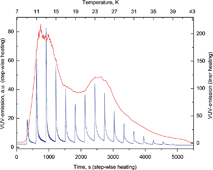An irradiation of solid argon sample by electrons ionizes the Ar atoms, and part of the beam energy is stored in the solid mainly in the form of self-trapped Ar2+ holes. The pre-irradiated samples are investigated by methods of the so called “activation spectroscopy”. During their controlled warm-up three thermally stimulated effects are observed and, in our experiments, simultaneously monitored: a VUV emission resulting from neutralization of the Ar2+ holes by electrons, an anomalous desorption of surface atoms, and an exoelectron emission. A comparison of experiments with linear and step-wise sample heating shows clearly that all three processes are intimately connected. The heating detraps electrons, which neutralize the Ar2+ holes resulting in a bound-free emission of argon dimers, centered around 9.7 eV. The excess energy set free during this process may dislodge surface atoms leading to an anomalous, low temperature, pressure rise. Some of the electrons can also be directly extracted from the sample and detected as an exoelectron current. The experiments provide information about the depth of electron traps, and indicate that there is a nearly continuous distribution of trapping energies.

You have access to this article
 Please wait while we load your content...
Something went wrong. Try again?
Please wait while we load your content...
Something went wrong. Try again?


 Please wait while we load your content...
Please wait while we load your content...